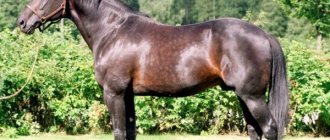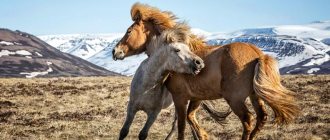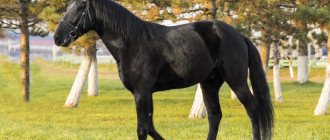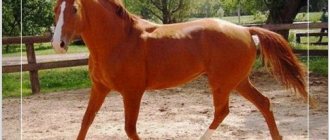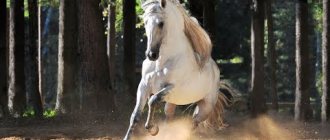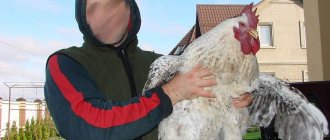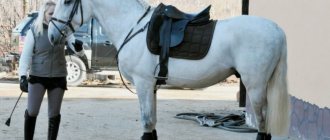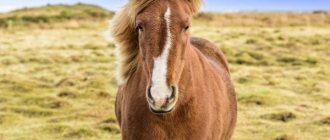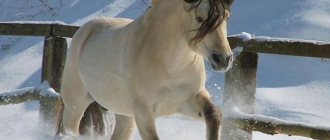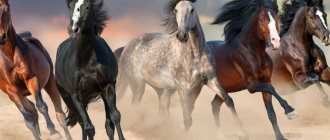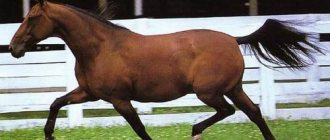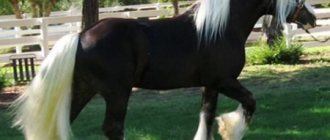The Budyonnovskaya breed of horses is the result of selection work carried out under the personal supervision of a historically significant personality, a man with a flexible mind and a great love for horses - Marshal of the Soviet Union Semyon Mikhailovich Budyonny. He unmistakably determined the presence of breed in horses, and accurately foresaw what would come out as a result of crossing.
The Budyonnovsky breed of horses is one of the best achievements of the employees of the institute, named after the Soviet military leader. Work on breeding the breed was carried out at stud farms named after. CM. Budyonny and them. The First Cavalry Army with the direct participation of Mikhail Ivanovich Chumakov, an experienced horse breeder and manager of the plant named after. CM. Budyonny. Officially, the Budennovskaya breed was registered in 1948.
Budennovskaya horse breed
The Budyonnovskaya breed of horses is the result of domestic selection; it was bred under the leadership of Semyon Budyonny, who wanted to get cavalry horses with endurance, unpretentiousness, agility and strength. The history of the breed began in the 20s of the last century. Its representatives combine the best qualities of their ancestors - Don and thoroughbred riding horses.
Ancestors
A new Budennovsky breed of horses was bred, the athletes had an excellent opinion about it, mainly based on lines (stallions). However, at the same time, breeding herds of animals with better qualities were also created. About 100 purebred stallions were used in breeding work. However, only four sires became the founders of the new breed. These were purebred horses Kokas, Svetets, Inferno and Pretty.
The Budyonnovskaya breed of horses is also interesting because in the process of its breeding no inbreeding was used at all. At the same time, animals were kept mainly using cultural herd technology. That is, large groups were formed according to different characteristics: sex, age and intrabreed types. The ancestors of the best lines of the breed are considered to be the Budennovsky stallions Bezha, Braslet, Chimkent and Codex.
Brief history of the Budennovsky breed
After the Civil War, the army was in dire need of reliable horses to serve the needs of the cavalry. Semyon Budyonny gave impetus to the beginning of selection work to develop a new breed. Several dozen purebred English stallions were brought to the Kuban stud farms, where the best Don mares were kept.
Reference. In the 19th century, attempts to cross these breed lines had already been made, but the work was not systematized and therefore did not lead to decent results.
Breeders under the leadership of generals appointed by Budyonny worked on creating a new breed for 25 years. During this time, 70 purebred English stallions and about 650 Don mares were used. Of the crossbred offspring, 3 horses had the best characteristics, from which the Budennovsk breed of horses was subsequently formed. The names of these stallions:
Horses were bred at Kuban stud farms using the cultural herd method. This method made it possible to more efficiently use stud stallions. The Budennovsky breed was registered in 1948.
In 1953, a thoroughbred English stallion named Rubilnik was born on the horse. He later became the founder of the dominant line in the Budennovsky horse breed . He was distinguished by his high ability to work, but had several shortcomings in his exterior. In addition, the stallion made high demands on living conditions and had a difficult character.
Thanks to the foresight of the breeder Lebedev, Rubilnik was nevertheless allowed for breeding, which gave excellent results. Today his line dominates the Budyonnovsky breed. It was from this stallion that offspring were obtained who later became Olympic medalists.
The development of mechanization influenced the future fate of the breed. Interest in equestrian sports was growing throughout the world. Budennovsky horses had the ideal set of qualities for competitions. Today they show excellent results in horse racing, eventing, dressage and show jumping.
Appearance
Budyonny's horses have excellent build and magnificent exterior. The horse is unusually graceful. Height at the withers (on average) is 1 m 67 cm (for a stallion) and 1 m 63 cm (for a mare).
“Budennovets” became famous throughout the planet. He has extraordinary physical characteristics:
- the head has a standard size, and the eyes are expressive;
- the neck is high, with developed withers;
- the back is wide;
- the lower back is muscular;
- massive croup;
- chest of ideal width;
- the limbs are excellent.
It is customary to distinguish 3 intrabreed types of “Budenovets”. Below is their description:
- Massive - large horses with a rough build and strong muscles. Not very playful. Most often they are used under saddle, as well as in the form of horse-drawn transport.
- Eastern ones resemble the Donetsk people in appearance. Most often they have a golden hue. The curves of the body are smooth. Animals of this type are proud. They are picky about care and food.
- Characteristic - large. They have well developed muscles. Their advantages include endurance and strength. They can develop high running speed.
Note! This breed is predominantly red in color with a golden tint. Black horses are practically absent. Bay and karak suits are less common.
Description and characteristics
Budennovsky horses ideally combine the best characteristics of Don and English riding horses. The animals are harmoniously built and have a strong and beautiful exterior, and their movements are light and graceful.
Exterior
Representatives of the Budennovsky breed are characterized by the following characteristics:
- height – 1.65 m;
- medium-sized head with a straight profile and a fairly wide forehead;
- the horses' neck is long and has a beautiful curve;
- the back is straight, strong, wide;
- medium length body;
- the sacrum is dense with well-developed muscles;
- the rear part is massive, slightly lowered;
- the ribs are rounded, the chest is wide and deep, girth – 1.89–1.91 m;
- strong, sinewy legs are of medium length;
- the joints are wide, elastic, and the hooves are very strong;
- the color is bay; most representatives of the breed have white spots on the forehead and bridge of the nose, as well as below the hocks.
Character and virtues
Budennovsky horses can hardly be called docile and peace-loving; they are characterized by temper and temper. These qualities were formed purposefully when the breed was created. The cavalrymen needed brave, persistent, strong horses with a “backbone”. Today, these character traits help horses reach heights in the sport.
Budennovsky horses are smart. They learn easily and apply the acquired knowledge. Another character trait is attachment to the owner. Horses are capable of being faithful and show obedience only to a person they respect and love.
Breeders note another quality inherent in representatives of the Budennovsky breed - endurance, which they inherited from the Donchak. Cavalry horses had to cover vast distances every day, being content with meager food. Sometimes they did not even have time to rest, and instead of sleep they entered into battle with enemy forces. All this hardened the horses. Today, their endurance helps them win high awards in sports.
The main advantages of the Budyonnovsky horse breed:
- strong immunity;
- resistance to temperature changes;
- undemanding to the food supply;
- unpretentiousness to living conditions;
- endurance.
The disadvantages of the breed include a difficult character and attachment to one person. For a sport horse, this is a disadvantage, since a large number of people have to work with it.
The Budennovsky horse becomes strongly attached to one person
Disadvantages of Budennovites
Many advantages of the Budennovsky breed were listed above, but not a single disadvantage was mentioned. But they do exist. The biggest thing is that these horses are monogamous.
This does not apply to love affairs between horses. Such devotion is shown towards the owner. The horse becomes very attached to one person who works with him and then with great difficulty makes contact with someone else.
For a modern horse this is a very big disadvantage. After all, a large number of people work with horses, and this character trait makes the work very difficult.
Also, these horses are quite impressionable. This scares off some horse breeders. This trait is the reason why the Budennovsky breed is inferior to German horses.
But, despite all their shortcomings, these horses are valued in our country and among foreigners. Many foreign horse breeders buy Budennovsky horses for themselves in order to breed new breeds and thereby improve their horses. Maybe, according to some indicators, Budennovsky breeds are inferior to some other breeds, but still they do not lose their popularity.
Now Budennovsky horses are bred at only three factories located in the Rostov region. These horses are truly versatile because they can be used in:
- horse racing;
- show jumping;
- dressage:
- triathlon.
The original appearance of the horses has not changed. Their color and other external characteristics remained the same. These horses are unpretentious, have great prospects in sports and are often used to improve other breeds of horses.
Athletes who worked with Budennovsk horses characterize them as active and flexible horses. They like to move a lot, but at the first notice of the rider they react to him and do not show much indignation. If you are an athlete and cannot choose a suitable horse for yourself, then opt for the Budennovsky horse. Not a single rider who chose this breed has ever regretted it.
Intrabreed types
During the breeding work, several types of horses of the Budennovsky breed were formed. They differ from each other in appearance:
- Horses of a characteristic type have strong bones, developed muscles and are distinguished by high performance.
- Representatives of the eastern type are owners of an elegant exterior with rounded shapes, which they inherited on their mother’s side, from mares of the Don breed.
- Massive horses are larger and have a rougher shape. In terms of agility they are inferior to their brothers.
Attention! Representatives of the same breed, bred at different stud farms, differ from each other in body type and some characteristics, for example, shade of coat color, head shape.
Ukrainian riding
The Ukrainian riding horse breed today is a good competitor to European riding breeds. The animals have excellent free and correct movements, a strong jump, and a harmonious structure. Temperament is lively. It is based on the best Italian horses - Furioso and Verniers, German Trakehnens and Hanoverians, as well as Arabian and Akhal-Teke horses, Hungarian, Friesian and Russian riding horses. Selection and selection for working qualities and exterior is carried out to this day - only the best representatives are selected for the breeding composition after testing for the quality of movement and jumping.
The result is an excellent athletic fighter, with withers up to 175 cm, a beautiful and expressive head, a long neck with a good poll and a high outlet. The back of horses is long, straight and muscular. The legs are strong, dry, with pronounced joints and tendons. The hooves are smooth and of regular shape. Black and dark bay representatives are most common; small markings are allowed on the exterior.
Where is the breed used today?
Budennovsky horses are in demand among athletes, as over many years they have proven themselves thanks to perseverance and endurance. They participate in horse racing, eventing and dressage competitions. These are some of the best show jumping horses - jumping is easy for them.
Constant training helps improve the breed, contrary to the belief that such a lifestyle negatively affects the offspring. The requirements for sport horses are becoming stricter every year, so work to improve the breed continues.
Famous representatives of the breed line
The Budyonnovsky breed can boast of champions. One of the most outstanding horses is Rex, the son of the stallion Knife and the mare named Epic of English-Danish origin. In 1980 he became an Olympic gold medalist. Many of Rubilnik’s descendants have distinguished themselves by high achievements in equestrian sports:
Another famous stallion of the Budennovsky breed is Zanos. In 1950, he became the winner of the daily race. Having spent only 19 hours, he managed to cover a distance of 109 km.
The Budennovsky breed of horses has absorbed all the best from its ancestors. She is highly valued by athletes. In addition to sport, these horses are used for hunting, and the most balanced and calm individuals are suitable for equestrian tourism and hippotherapy.
Character
Stallions and mares are tolerant and flexible. Athletes say that the Budenovsky breed of horses stands out for its intelligence. In rare cases, individuals show character and become capricious. Modern individuals have inherited a similar disposition from the stallion Rubinchik, who was distinguished not only by his stunning exterior and impeccable racing skills, but also by his constantly changing character.
It is very difficult to obtain offspring from such an animal. The character and behavior of individuals are generally assessed as good.
Every day, an increasing number of breeders want to purchase Budyonny horses. What is the reason for such popularity? Budennovsky horses are so desirable because they demonstrate excellent performance in various competitions. They show slightly worse results in smooth racing compared to representatives of the purebred riding breed. Budennovsky individuals have a good performance in distance runs. Excellent performance was demonstrated by the stallions Brev Boy and Surguch, who ran 300 km in the daily race.
Historical data
The history of breeding Budyonnovsky began in the twenties of the last century. The founder of the breed is considered to be Marshal Budyonny, who sought to create a universal horse for the cavalry. To do this, he placed generals and commanders of the First Cavalry Army at the head of the horse farms. It was decided that a new breed would be created by crossing “English” stallions of pure blood and mares of the Don breed - both of them were characterized by excellent racing qualities and correct physique.
During the Second World War, Budennovtsy brought invaluable assistance, transporting heavy weapons and supplies on impassable roads. After the war, this breed received official status. It was recognized by the Council of Ministers of the USSR by its resolution number 4210.
In the first decade after the war, thanks to only one stallion named Rubilnik, it was possible to create the ideal appearance of a horse of the Budennovsky breed, which is still the standard.
During the twenty post-war years, the need for a cavalry army and the massive use of horses in agriculture disappeared. The Budennovsky breed changes its purpose and becomes sport-oriented. All the qualities of an army horse are ideal for this. It is from this moment until the present time that approximately a third of the total number of young animals is selected, from which the breeding stock is formed - only the most hardy, fast and beautiful stallions are suitable for this. All purebred horses are recorded in the breed's studbook, which is updated every year.
The Budennovsky breed is considered universal for sports. Horses can take part in any competition, from racing to dressage.
Description of the breed
Budennovtsy are beautifully built and very graceful. One look at a thoroughbred horse is enough to imagine its strength and power. Males are practically no different from mares in both height and body length.
Appearance
The Budennovsky breed horse is a fairly large animal. She has the correct body proportions, developed muscles and bones.
Scope of application
The Budennovsky breed of horses can be used quite widely. The main focus is sports, where she has proven herself well. These horses can take part in all competitions. They cope well with obstacle courses in races, participate in horse racing, eventing, dressage, and show jumping. In terms of demand in sports, Budyonnovtsy are the third in the world leaders.
Due to their exceptional endurance, horses are successfully used in agriculture. They are wonderful assistants in transporting heavy loads and cultivating agricultural land. In rural areas they are also a means of transportation. Thanks to their flexible disposition, they feel good in a harness or cart.
Horses of the Budennovsky breed are quite easy to maintain, so they are raised for active recreation, hunting, and entertainment. Hippotherapy, a treatment involving horses, is now very popular. The large, flexible Budyonnovsk resident shows excellent results in this direction.
Due to their good racing qualities and endurance, representatives of the Budyonnovsky breed help herd large herds of domestic animals and drive them over long distances. The horse feels the rider perfectly.
Character
Horses of the Budennovsky breed are distinguished by high intelligence. They are easy to train, friendly and easy-going. At the same time, they are persistent and hardy, since they were originally bred for the needs of the army. Budennovtsy are quite brave and playful.
Some horses may have a wayward and obstinate character. This can create trouble in a herd, so such individuals are usually isolated. Subsequently, these shortcomings can be corrected and obedience achieved.
The Budennovsky horse differs from its brothers in that it quickly gets used to its owner and carries out only his commands. Thus, he becomes a true friend of his owner.
Advantages and disadvantages
- Horses of the Budennovsky breed have a lot of advantages, namely:
- endurance;
- courage;
- excellent physical characteristics;
- lack of aggression;
- proportional physique;
- flexible, kind character;
- simplicity and economy of content;
- remarkable mental abilities;
- excellent learning ability;
- contact;
- independence and activity;
- good coordination;
- good jumping ability.
- Among the few disadvantages are:
- in some cases there is a wayward character; sometimes there are snappy individuals;
- parting with the owner is stressful for the Budyonnovets;
- Sometimes nervousness and excessive impressionability appear.
Interesting Facts
- Due to their stamina and endurance, Budennovsky horses are recognized as worthy steeplechase horses. Therefore, they often participate in steeplechase rallies, for example at a rally in Pardubice, where a Budennovsky horse named Priboi won a successful victory.
- The appearance of the Budennovskaya horse breed was due to the lack of repair horses for domestic cavalry officers. Therefore, the modern Budennovskaya horse is playful, persistent and unpretentious.
- In order for a horse to feel great and develop, it needs a veterinary examination, regular food, and decent living conditions. Therefore, even a beginner in horse farming can become the owner of a Budennovka.
- The Budyonnovsky breed horse already has more than one Olympic medal and global recognition due to regular victories in competitions. Until today, Russian horses compete at the same level for victory in competitions with European horses.
- Among the most famous Budyonnovsk horses, everyone will remember the winner of the 1980 Olympics, a horse named Reis, as well as such glorious representatives of the breed as Embargo, Daring, Idealist and Rakitnik.
- The genetic relationship of the Budennovsk horses with English thoroughbred riding horses gives the Russian horse the opportunity to win smooth races.
Keeping at home
Keeping a Budennovsk horse at home does not require any special recommendations. She needs an ordinary stable, care without any special frills. This is one of the reasons for its high popularity among breeders.
Stable
A stable is a place where a horse spends a lot of time and rests. Therefore, it is in the stall that it is important to provide her with maximum comfort. The stall must correspond to the large size of the animal. The Budyonnovsky horse is considered large, it needs a little more space than a regular one - a stall measuring 3 by 3 meters is considered standard, but horse breeders say that the optimal size will be 4 by 4 meters.
The stable itself should be made of wood or brick, fairly well insulated and covered with a durable roof. The place for it should be on a hill, away from groundwater - dampness and high humidity are harmful to horses. There should be no drafts in the room, but there should be enough fresh air. To do this, the walls are insulated, windows and openings are made in them for natural ventilation; hatches that are located almost under the ceiling are very popular.
As a rule, if there are few animals, then natural ventilation is sufficient. It also helps remove harmful gases from the room that arise during the life of the animal.
The floor in the stall can be made of a variety of materials: clay, concrete, wood, rubber-coated. A prerequisite is that it is not slippery. Concrete can be cold in the winter, and urine can seep through the cracks in wood and it quickly becomes unusable, so many recommend using an adobe floor, which is changed as needed. A hay bedding is placed on top of it, on which the animal can rest; it should be about 5 cm thick. You can also use sawdust for bedding - they absorb moisture well.
The stall should be equipped with feeders and drinkers. The feeder is made of two parts: one of them must always contain hay, and the second compartment is filled with feed, vegetables and other horse food. Ideally, feeders should be made in such a way that you do not need to go inside the stall to fill and clean them. A horse can drink from a bucket-type drinker or an automatic one. Feeders should not be near drinking bowls - in this case, water will get on the food.
The stable should have a comfortable temperature and lighting. Budyonnovsky differs from many breeds in that it tolerates both cold and heat quite well. Of course, very severe frost and heat are harmful to them, so in winter it is recommended to maintain the temperature at least 10°C, optimally around 15°C. In summer, the stall should be ventilated whenever possible.
Proper nutrition
What should be included in the diet
A proper diet is the key to a healthy horse and efficient performance under saddle. The menu should include:
- hay;
- straw;
- fresh grass (in summer);
- bran;
- oats;
- muesli;
- vitamins;
- carrots, apples, watermelon rinds.
Proportions are calculated depending on the load - the type of sport in which the Don breed horse is involved.
In the summer, a young horse needs to eat an average of 3-4 kilograms of hay. 2 kilograms of straw. One standard bucket of oats. Walking - at least 2 hours a day.
In winter, bran, vitamins, and muesli are added to the diet. And also feed additives.
Vegetables and fruits are given 3-4 times a week. It will not be harmful to give the animal salt and feed chalk as sources of microelements.
Budyonnovsky horse: features and breeding prospects
The Budennovskaya breed is one of the youngest in domestic horse breeding. It was brought out right at the end of the era of horses, when machines were already successfully replacing human draft power. Initially, the breed was conceived as a riding and draft breed for the needs of the army. However, she never had time to prove herself in this role, quickly moving into the category of sports breeds.
History of the Budennovsk horse
The Civil War in Russia caused significant damage to the domestic horse breeding. The horse breeding farms in the southern part of the country suffered especially hard, where most of the stud farms were practically destroyed, and the purebred herds accumulated over decades were lost. At the same time, the country, and especially the Red Army, was in dire need of horses, which at that time were the main striking force and the main mode of transport, both in the rear and at the front.
Work on creating a new army breed began in the mid-1920s at the Kuban stud farms, which were supervised by Army Commander Budyonny himself. The “First Horseman of the Red Army” made sure that these enterprises created the most comfortable working conditions for the staff, and appointed former brothers-in-arms from the First Cavalry Army, whom he knew personally, as managers.
The source material for creating the new breed was the English riding horse and the local Don horse. This is why the Don and Budennovsk horse breeds have so many common features.
Although attempts to cross the English and Don breeds have already taken place in the past, only now they have taken up the matter with all the scope inherent in the Soviet economy. When breeding the Budennovsky breed, Don mares and English stallions were used, and only the best representatives of their breed were used, who proved themselves to be excellent horses with the right physique. Despite the fact that several dozen stallions and hundreds of mares were involved in the selection work, only three stallions are officially considered the ancestors of the breed.
By the standards of livestock breeding, the creation of the breed took place at an unusually fast pace. However, the official registration of the Budyonny horse took place only in November 1948. By this time, the motorization of the army was proceeding at an even faster pace: horses were no longer planned to be used on the battlefield, and they were rapidly being replaced by vehicles in supply.
Reviews
Roman Korovayny, p. Novoivanovskoe
Our area is such that in all the villages only the Budennovskys and Donskys are running around. As a last resort, their crosses. In addition to large factories, previously almost every collective and state farm had a breeding farm. As the collapse began, collective farms began to get rid of horses. Often wages were paid in horses. So they bred the horses into private hands. I read that they are considered evil, but they are horses like horses. I bought myself a Budyonnovets. I was looking for a small one so that it would be convenient to harness to the cart. He went into the collar just like he was born there. And it pulls well. Enough for farming.
Tatyana Lozinskaya, pos. Southern
When we decided to organize horseback riding for tourists, we recruited Budennovsky horses from a nearby farm. Of course, they chose who was calmer. The newcomers should be imprisoned. Horses are good because they are not afraid of cars or animals. And there is no risk that they will fall somewhere on the descent.
Budenovskaya horse breed - photo, video, description
Budennovskaya is a classic riding breed that has all the characteristic features of a horse. She has well-developed withers, a long shoulder blade covered with powerful muscles, a massive chest and well-positioned limbs. The body constitution as a whole is very strong and powerful, but at the same time moderately dry.
The sizes of stallions and mares are almost the same. On average, they reach 165 centimeters at the withers with a similar body length. The girth of the chest is about 189 centimeters, the metacarpus is almost 21 centimeters.
Breeders involved in this breed pay special attention to such parameters as size, broadness and boneiness. This is easy to notice when looking at a photo of a Budennovsky horse. The largest animals today are kept at the KZ named after. 1st Cavalry Army: stallions there often grow higher than 1.7 m at the withers or even higher.
The vast majority of horses of the Budennovsky breed are red in color. At the same time, almost all its shades are found. There are also quite a few bays. The red ones are especially beautiful, since their coat has a golden hue, which they inherited from the Don horses.
The Budyonnovsky breed is not entirely homogeneous. There is a division into three intra-breed subtypes:
- Characteristic. Animals of this subtype contain approximately equally features of both the Don and English riding breeds. These are large animals with well-developed muscles and excellent performance. It is this subtype that is considered the standard, and therefore it is most often shown in photos of the Budennovsk horse breed.
- Oriental. This subtype includes horses in which the traits of Don horses dominate. The body of these animals has smoother and more rounded shapes, which gives the horses a more elegant appearance.
- Massive. This is the largest subtype. Horses have simpler or even coarser body shapes, and in terms of agility they are noticeably inferior to representatives of the first two types.
It should be noted that in addition to the three general subtypes, each of the above-mentioned horse farms also breeds its own factory subtype. For example, horses with KZ named after. The cavalry army is more angular and rough, while the Yulov army, on the contrary, is as elegant as possible.
As for character, these are quite active and very energetic animals, which, however, obey the commands of the rider well. In general, these horses can be described as playful, but docile.
Photo gallery
Budennovskaya horse with foal
Budennovsky horses grazing
Budyonnovsky horse
Budyonnovsky horse - face
How Budennovsky horses are bred
The largest population of the Budennovsk breed of horses is in the Stavropol region, in the Krasnodar region and, in fact, in the Rostov region, where all three large farms are located.
Stud farms specializing in the breed practice the herd method, in which mares and young stock are kept together. This technique allows for the selection of animals by character. Since the herd grazes in a strictly limited space, aggressive individuals are very easy to identify, since they quickly come into conflict with the rest of the herd. Restful animals are removed from the herd, and therefore from the gene pool. Thus, in each next generation it is possible to obtain more and more flexible, patient and contact horses with good reaction and intelligence.
After weaning the young animals from the general broodstock, two separate herds are formed from them - stallions separately, mares separately. The most promising young animals do not enter these herds; they are sent to the so-called “cult group”. Animals that need to undergo racing training, or those that are most promising for breeding, are kept here.
Today, all breeding horses of this breed are necessarily included in the all-Russian stud book, which is published annually. Thanks to this, each animal has a passport issued by the All-Russian Scientific Research Institute of Horse Breeding.
Growing
Queens and young animals are kept in groups (herds). This is the specificity of breeding Budennovsky horses - rearing using the herd method. In this way, animals are sorted according to their psychotype, further refuting the prevailing opinion about the willfulness and stubbornness of horses raised in relative freedom.
The fact is that quarrelsome, uncontrollable Budennovsky mares cause inconvenience to the entire herd on a very limited pasture. This is how artificial selection occurs - conflicting individuals are removed from the group. It’s better not to think about what happens to them next. The large group method develops in horses an easy-going character, sociability and patience, but at the same time – good reaction and intelligence.
At the end of September and until November (the duration depends on the weather and several other factors), the foals are weaned from their mothers. Moreover, regardless of the date of birth - all together, both winter and spring offspring. But first – mandatory branding. In a relatively humane, cold way, the withers of the foal on the left are tamed. The brand contains information about the individual number and year of birth, with the plant emblem. The horses with the emblem on the left hip are products of the Budennovsky stud farm.
Young animals are collected into groups divided by gender. A so-called cult group is created from those who are promising. This definition came into use and was consolidated from the time when young stallions were removed from the livestock, which were always in large groups, with a claim to the sire and such “cult groups” were formed. Now they select horses that are promising, from the point of view of the plant’s specialists, in terms of sports or breeding. In stalls, foals from the cult group are kept in pairs, gradually reintroducing them, accustoming them to the rope, the people around them and their own nicknames.
Adult life for thoroughbred Budennovsky horses begins at the age of two with trials at the hippodrome of the city of Rostov. Running at the limit of more than 1 kilometer is called “smooth racing”. Unlike prize breeds, only 15–25% of selected breeds are allowed to take part in trials. This extreme type of physical activity makes it possible to select specimens that can withstand them and bring their potential to the development of the breed.
Today, almost all stud stallions have successfully passed these tests, showing excellent results. The selected mares of the brood stock did not disappoint either - more than half overcame the tests with smooth jumps.
Every year a new copy of the volume of the State Stem Book is published, which includes all purebred horses. To confirm that this is a Budennovsk breed of horse, the All-Russian Research Institute of Horse Breeding issues a passport. Every year, stud stallions are assessed by breeders from the Institute, followed by publication. NIIK employees use this information to analyze, control and improve the quality of the offspring of the Budennovskaya breed.
